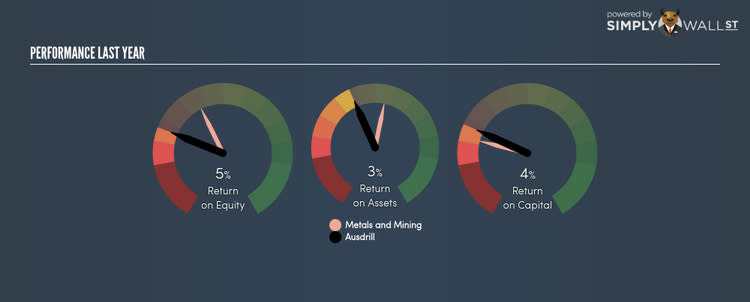With An ROE Of 5.08%, Has Ausdrill Limited’s (ASX:ASL) Management Done A Good Job?

Ausdrill Limited’s (ASX:ASL) most recent return on equity was a substandard 5.08% relative to its industry performance of 11.83% over the past year. An investor may attribute an inferior ROE to a relatively inefficient performance, and whilst this can often be the case, knowing the nuts and bolts of the ROE calculation may change that perspective and give you a deeper insight into ASL’s past performance. I will take you through how metrics such as financial leverage impact ROE which may affect the overall sustainability of ASL’s returns. See our latest analysis for ASL
What you must know about ROE
Return on Equity (ROE) is a measure of ASL’s profit relative to its shareholders’ equity. An ROE of 5.08% implies A$0.05 returned on every A$1 invested. In most cases, a higher ROE is preferred; however, there are many other factors we must consider prior to making any investment decisions.
Return on Equity = Net Profit ÷ Shareholders Equity
Returns are usually compared to costs to measure the efficiency of capital. ASL’s cost of equity is 11.58%. Given a discrepancy of -6.50% between return and cost, this indicated that ASL may be paying more for its capital than what it’s generating in return. ROE can be broken down into three different ratios: net profit margin, asset turnover, and financial leverage. This is called the Dupont Formula:
Dupont Formula
ROE = profit margin × asset turnover × financial leverage
ROE = (annual net profit ÷ sales) × (sales ÷ assets) × (assets ÷ shareholders’ equity)
ROE = annual net profit ÷ shareholders’ equity
Essentially, profit margin shows how much money the company makes after paying for all its expenses. Asset turnover reveals how much revenue can be generated from ASL’s asset base. Finally, financial leverage will be our main focus today. It shows how much of assets are funded by equity and can show how sustainable ASL’s capital structure is. Since ROE can be artificially increased through excessive borrowing, we should check ASL’s historic debt-to-equity ratio. Currently the debt-to-equity ratio stands at a reasonable 61.67%, which means its ROE is driven by its ability to grow its profit without a significant debt burden.
What this means for you:
Are you a shareholder? ASL’s below-industry ROE is disappointing, furthermore, its returns were not even high enough to cover its own cost of equity. However, investors shouldn’t despair since ROE is not inflated by excessive debt, which means ASL still has room to improve shareholder returns by raising debt to fund new investments. If you’re looking for new ideas for high-returning stocks, you should take a look at our free platform to see the list of stocks with Return on Equity over 20%.
Are you a potential investor? If ASL has been on your watch list for a while, making an investment decision based on ROE alone is unwise. I recommend you do additional fundamental analysis by looking through our most recent infographic report on Ausdrill to help you make a more informed investment decision.
To help readers see pass the short term volatility of the financial market, we aim to bring you a long-term focused research analysis purely driven by fundamental data. Note that our analysis does not factor in the latest price sensitive company announcements.
The author is an independent contributor and at the time of publication had no position in the stocks mentioned.


